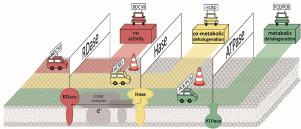Water Research ( IF 11.4 ) Pub Date : 2022-06-07 , DOI: 10.1016/j.watres.2022.118725 Rui Shen 1 , Shangwei Zhang 1 , Zhiwei Liang 1 , Bixian Mai 2 , Shanquan Wang 1

|
Hexachloro-1,3-butadiene (HCBD) as one of emerging persistent organic pollutants (POPs) poses potential risk to human health and ecosystems. Organohalide-respiring bacteria (OHRB)-mediated reductive dehalogenation represents a promising strategy to remediate HCBD-contaminated sites. Nonetheless, information on the HCBD-dechlorinating OHRB and their dechlorination pathways remain unknown. In this study, both in vivo and in vitro experiments, as well as quantum chemical calculation, were employed to successfully identify and characterize the reductive dechlorination of HCBD by Dehalococcoides. Results showed that some Dehalococcoides extensively dechlorinated HCBD to (E)-1,2,3-tri-CBD via (E)-1,1,2,3,4-penta-CBD and (Z,E)-1,2,3,4-tetra-CBD in a co-metabolic way. Both qPCR and 16S rRNA gene amplicon sequencing analyses suggested that the HCBD-dechlorinating Dehalococcoides coupled their cell growth with dechlorination of perchloroethene (PCE), rather than HCBD. The in vivo and in vitro ATPase assays indicated ≥78.89% decrease in ATPase activity upon HCBD addition, which suggested HCBD inhibition on ATPase-mediated energy harvest and provided rationality on the Dehalococcoides-mediated co-metabolic dechlorination of HCBD. Interestingly, dehalogenation screening of organohalides with the HCBD-dechlorinating enrichment cultures showed that debromination of bromodichloromethane (BDCM) was active in the in vitro RDase assays but non-active in the in vivo experiments. Further in vitro assays of hydrogenase activity suggested that significant inhibition of BDCM on the hydrogenase activity could block electron derivation from H2 for consequent reduction of organohalides in the in vivo experiments. Therefore, our results provided unprecedented insight into metabolic, co-metabolic and RDase-active-only dehalogenation of varied organohalides by specific OHRB, which could guide future screening of OHRB for remediation of sites contaminated by HCBD and other POPs.
中文翻译:

Dehaloccoides中六氯-1,3-丁二烯共代谢脱氯的机理研究
六氯-1,3-丁二烯 (HCBD) 作为一种新兴的持久性有机污染物 (POPs) 对人类健康和生态系统构成潜在风险。有机卤化物呼吸细菌 (OHRB) 介导的还原脱卤是修复六氯丁二烯污染场地的一种有前途的策略。尽管如此,关于六氯丁二烯脱氯 OHRB 及其脱氯途径的信息仍然未知。在这项研究中,采用体内和体外实验以及量子化学计算,成功地鉴定和表征了脱卤球菌对六氯丁二烯的还原脱氯作用。结果表明,一些Dehalococcoides通过 ( E )将 HCBD 广泛脱氯为 ( E )-1,2,3-tri-CBD)-1,1,2,3,4-penta-CBD 和 ( Z,E )-1,2,3,4-tetra-CBD 以共代谢方式。qPCR 和 16S rRNA 基因扩增子测序分析均表明,六氯丁二烯脱氯脱卤球菌将其细胞生长与全氯乙烯 (PCE) 脱氯相结合,而不是六氯丁二烯。体内和体外ATP 酶测定表明,添加六氯丁二烯后 ATP 酶活性降低 ≥78.89%,这表明六氯丁二烯抑制了 ATP 酶介导的能量收集,并为Dehalococcoides提供了合理性介导的六氯丁二烯的共代谢脱氯。有趣的是,用六氯丁二烯脱氯富集培养物对有机卤化物进行脱卤筛选表明,溴二氯甲烷 (BDCM) 的脱溴在体外RDase 测定中具有活性,但在体内实验中没有活性。对氢化酶活性的进一步体外测定表明,BDCM 对氢化酶活性的显着抑制可以阻止从 H 2的电子衍生,从而在体内还原有机卤化物实验。因此,我们的研究结果为特定 OHRB 对各种有机卤化物的代谢、共代谢和仅 RDase 活性脱卤提供了前所未有的见解,这可以指导未来筛选 OHRB 以修复被六氯丁二烯和其他 POPs 污染的场地。











































 京公网安备 11010802027423号
京公网安备 11010802027423号